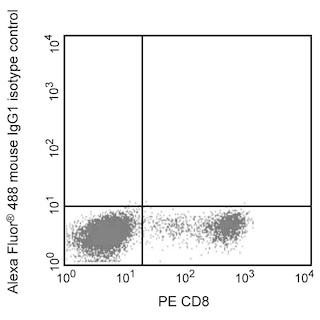Old Browser
This page has been recently translated and is available in French now.
Looks like you're visiting us from {countryName}.
Would you like to stay on the current country site or be switched to your country?




.png)

Flow cytometric analysis of Alkaline Phosphatase expression on human embryonic stem (ES) cells. H9 human ES cells (WiCell, Madison, WI) passage 45 grown in mTeSR™1 medium (StemCell Technologies) on BD Matrigel™ hESC-qualified Matrix (Cat. No. 354277) were harvested and stained with Alexa Fluor® 488 Mouse anti-Human Alkaline Phosphatase antibody (solid line) or Alexa Fluor® 488 mouse IgG1, κ isotype control (Clone MOPC-21, Cat. No. 557702, dashed line). Flow cytometry was performed on a BD LSR™ II flow cytometry system.

Immunoflourescent staining of Alkaline Phosphatase on human embryonic stem (ES) cells. H9 human ES cells (WiCell, Madison, WI) passage 34 grown on irradiated mouse embryonic fibroblasts were fixed with BD Cytofix™ Fixation Buffer (Cat. No. 554655) and stained with Alexa Fluor® 488 Mouse anti-Human Alkaline Phosphatase monoclonal antibody (pseudo-colored green) at 5 μg/mL. Cell nuclei were counter-stained with Hoechst 33342 (pseudo-colored blue). The images were captured on a BD Pathway™ 435 Cell Analyzer and merged using BD Attovision™ Software.
.png)

BD Pharmingen™ Alexa Fluor® 488 Mouse anti-Human Alkaline Phosphatase

BD Pharmingen™ Alexa Fluor® 488 Mouse anti-Human Alkaline Phosphatase
.png)
Regulatory Status Legend
Any use of products other than the permitted use without the express written authorization of Becton, Dickinson and Company is strictly prohibited.
Preparation And Storage
Product Notices
- This reagent has been pre-diluted for use at the recommended Volume per Test. We typically use 1 × 10^6 cells in a 100-µl experimental sample (a test).
- Please refer to www.bdbiosciences.com/us/s/resources for technical protocols.
- An isotype control should be used at the same concentration as the antibody of interest.
- Alexa Fluor® 488 fluorochrome emission is collected at the same instrument settings as for fluorescein isothiocyanate (FITC).
- For fluorochrome spectra and suitable instrument settings, please refer to our Multicolor Flow Cytometry web page at www.bdbiosciences.com/colors.
- The Alexa Fluor®, Pacific Blue™, and Cascade Blue® dye antibody conjugates in this product are sold under license from Molecular Probes, Inc. for research use only, excluding use in combination with microarrays, or as analyte specific reagents. The Alexa Fluor® dyes (except for Alexa Fluor® 430), Pacific Blue™ dye, and Cascade Blue® dye are covered by pending and issued patents.
- Alexa Fluor® is a registered trademark of Molecular Probes, Inc., Eugene, OR.
- mTESR™1 is a trademark of StemCell Technologies.
- Caution: Sodium azide yields highly toxic hydrazoic acid under acidic conditions. Dilute azide compounds in running water before discarding to avoid accumulation of potentially explosive deposits in plumbing.
- Source of all serum proteins is from USDA inspected abattoirs located in the United States.
Companion Products



The B4-78 monoclonal antibody reacts with the tissue-nonspecific isozyme of alkaline phosphatase. Alkaline phosphatases are membrane-bound glycoproteins. Four isozymes of alkaline phosphatase exist in humans: placental, placental-like, intestinal, and liver/bone/kidney. Liver/bone/kidney alkaline phosphatase is also known as tissue-nonspecific alkaline phosphatase (TNAP). Human embryonic stem cells and embryonic carcinoma cells express high levels of tissue-nonspecific alkaline phosphatase that decrease upon differentiation. Genetic and biochemical studies suggest that TNAP plays a role in skeletal mineralization.
Development References (7)
-
Addison WN, Sorensen ES, Kaartinen MT, McKee MD. Pyrophosphate inhibits mineralization of osteoblast cultures by binding to mineral, up-regulating osteopontin, and inhibiting alkaline phosphatase activity. J Biol Chem. 2007; 282(21):15872-15883. (Biology). View Reference
-
Dorheim MA, Sullivan M, Dandapani V, et al. Osteoblastic gene expression during adipogenesis in hematopoietic supporting murine bone marrow stromal cells. J Cell Physiol. 1993; 154(2):317-328. (Clone-specific: Immunocytochemistry (cytospins)). View Reference
-
Eghbali-Fatourechi GZ, Lamsam J, Fraser D, Nagel D, Riggs BL, Khosla S. Circulating osteoblast-lineage cells in humans. N Engl J Med. 2005; 352(19):1959-1966. (Clone-specific: Flow cytometry). View Reference
-
International Stem Cell Initiative. Characterization of human embryonic stem cell lines by the International Stem Cell Initiative. Nat Biotechnol. 2007; 25(7):803-816. (Biology). View Reference
-
Karp JM, Ferreira LS, Khademhosseini A, Kwon AH, Yeh J, Langer RS. Cultivation of human embryonic stem cells without the embryoid body step enhances osteogenesis in vitro. Stem Cells. 2006; 24:835-843. (Biology). View Reference
-
Lawson GM, Katzmann JA, Kimlinger TK, O'Brien JF. Isolation and preliminary characterization of a monoclonal antibody that interacts preferentially with the liver isoenzyme of human alkaline phosphatase. Clin Chem. 1985; 31(3):381-385. (Immunogen). View Reference
-
O'Connor MD, Kardel MD, Iosfina I, et al. Alkaline phosphatase-positive colony formation is a sensitive, specific, and quantitative indicator of undifferentiated human embryonic stem cells. Stem Cells. 2008; 26(5):1109-1116. (Biology). View Reference
Please refer to Support Documents for Quality Certificates
Global - Refer to manufacturer's instructions for use and related User Manuals and Technical data sheets before using this products as described
Comparisons, where applicable, are made against older BD Technology, manual methods or are general performance claims. Comparisons are not made against non-BD technologies, unless otherwise noted.
For Research Use Only. Not for use in diagnostic or therapeutic procedures.
Report a Site Issue
This form is intended to help us improve our website experience. For other support, please visit our Contact Us page.